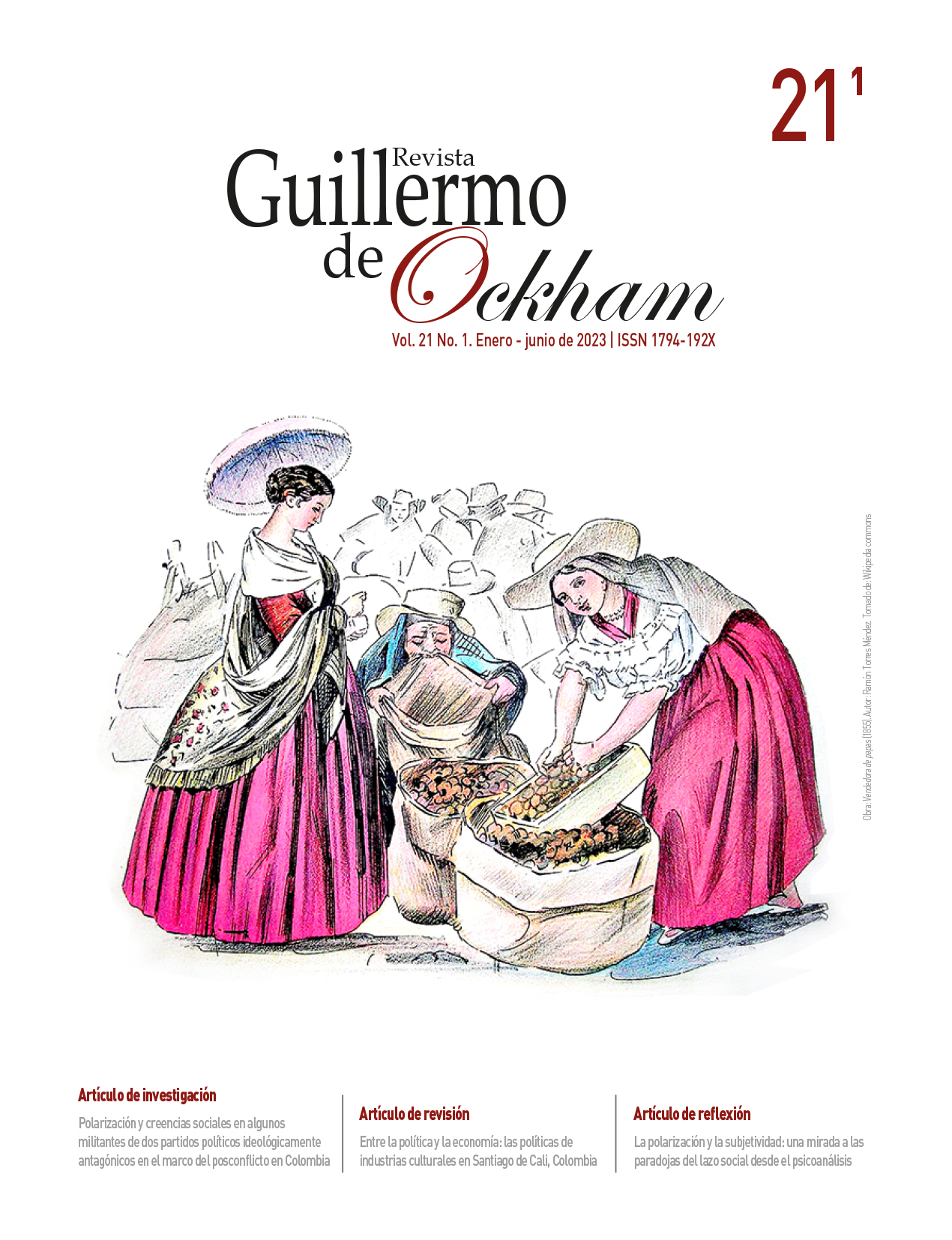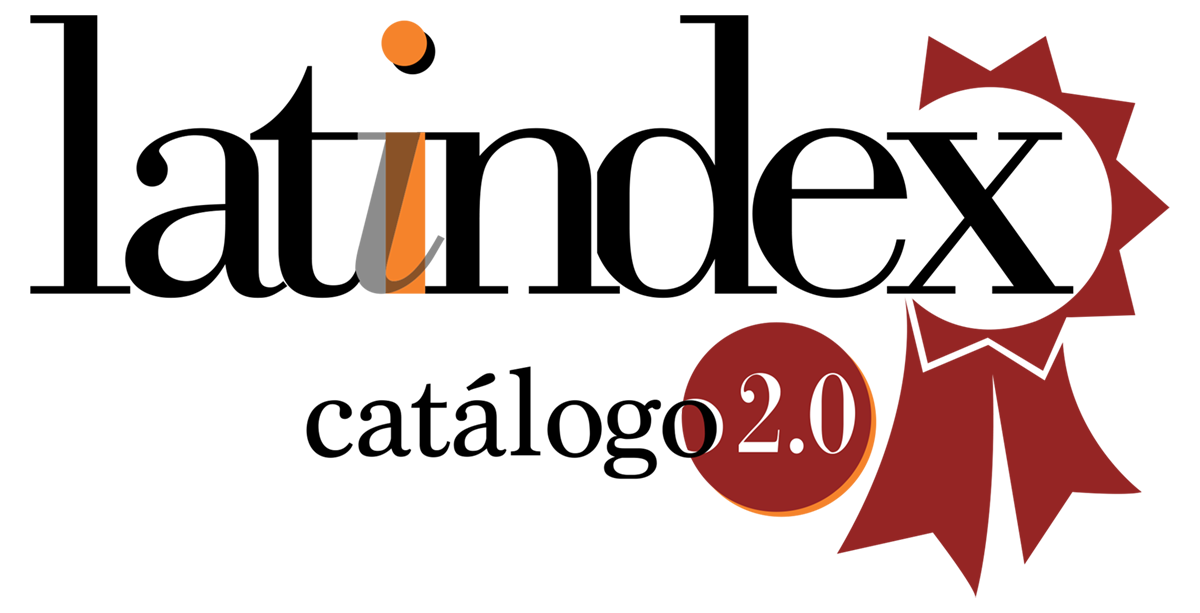The Revista Guillermo de Ockham provides an immediate and open access to its content, based on the principle of offering the public a free access to investigations to provide a global interchange of knowledge.
Unless otherwise established, the contents of this journal has a license with Creative Commons Attribution-NonCommercial-NoDerivatives 4.0 International (CC BY-NC-ND 4.0) http://creativecommons.org/licenses/by-nc-nd/4.0/
- Attribution: You must give appropriate credit, provide a link to the license, and indicate if changes were made. You may do so in any reasonable manner, but not in any way that suggests the licensor endorses you or your use.
- NonCommercial: You may not use the material for commercial purposes.
- NoDerivatives: If you remix, transform, or build upon the material, you may not distribute the modified material.
- No additional restrictions: You may not apply legal terms or technological measures that legally restrict others from doing anything the license permits.
Abstract
The aim of the research was to analyze and evaluate the existing literature on eWOM by means of a bibliometric analysis, which included important scientific mapping tools. Thus, a bibliographic search was carried out in the Scopus database, which yielded 841 publications, which were analyzed on the basis of three types of indicators: quantity, quality and structural. Likewise, to achieve a better visualization of the information, VOSviewer software was used to generate bibliometric networks of bibliographic coupling and co-occurrence of terms, with which the main areas of research were identified. Based on the above, it became evident that the studies in eWOM have had a progressive growth in the last 5 years, which have been led by developed countries such as the United States, Taiwan and Spain; however, there is little representation of Latin American countries. Finally, based on a qualitative analysis of the most recent literature, future lines of research for the development of complementary studies were identified.
Keywords:
References
Araújo, C. A. A. (2006). Bibliometria: evolução histórica e questões atuais. Em Questão, 12(1), 11-32. https://seer.ufrgs.br/index.php/EmQuestao/article/view/16
Ardanuy, J. (2012, abril). Breve introducción a la bibliometría. Universitat de Barcelona. https://bit.ly/3wH7eym
Babić, A., De Valck, K., y Sotgiu, F. (2020). Conceptualizing the electronic Word-of-mouth process: What we know and need to know about eWOM creation, exposure, and evaluation. Journal of the Academy of Marketing Science, 48(3), 422-448. https://doi.org/10.1007/s11747-019-00706-1
Bansal, H. S., y Voyer, P. A. (2000). Word-of-mouth processes within a services purchase decision context. Journal of Service Research, 3(2), 166-177. https://doi.org/10.1177/109467050032005
Cadavid, L., Awad, G., y Franco, C. J. (2012). Análisis bibliométrico del campo modelado de difusión de innovaciones. Estudios Gerenciales, 28(EE), 213-236. https://doi.org/10.18046/j.estger.2012.1486
Cañedo, R., Rodríguez, R., y Montejo, M. (2010). Scopus: la mayor base de datos de literatura científica arbitrada al alcance de los países subdesarrollados. Revista Cubana de ACIMED, 21(3), 270-282. http://www.redalyc.org/articulo.oa?id=377657496004
Chan, Y. Y. Y., y Ngai, E. W. T. (2011). Conceptualising electronic word of mouth activity: An input-process-output perspective. Marketing Intelligence and Planning, 29(5), 488-516. https://doi.org/10.1108/02634501111153692
Cheung, C. M. K., Lee, M. O. K., y Rabjohn, N. (2008). The impact of electronic word-of-mouth: The adoption of online opinions in online customer communities. Internet Research, 18(3), 229-247. https://doi.org/10.1108/10662240810883290
Cheung, M. Y., Luo, C., Sia, C. L., y Chen, H. (2009). Credibility of electronic word-of-mouth: Informational and normative determinants of on-line consumer recommendations. International Journal of Electronic Commerce, 13(4), 9-38. https://doi.org/10.2753/jec1086-4415130402
Chu, S. C., Chen, H. T., y Gan, C. (2020). Consumers’ engagement with Corporate Social Responsibility (CSR) communication in social media: Evidence from China and the United States. Journal of Business Research, 110, 260-271. https://doi.org/10.1016/j.jbusres.2020.01.036
Chu, S. C., y Kim, Y. (2011). Determinants of consumer engagement in electronic Word-Of-Mouth (eWOM) in social networking sites. International Journal of Advertising, 30(1), 47-75. https://doi.org/10.2501/IJA-30-1-047-075
Dellarocas, C. (2003). The digitization of word of mouth: Promise and challenges of online feedback mechanisms. Management Science, 49(10), 1407-1424. https://www.jstor.org/stable/4134013
Dwyer, P. (2007). Measuring the value of electronic word of mouth and its impact in consumer communities. Journal of Interactive Marketing, 21(2), 63-79. https://doi.org/10.1002/dir.20078
Goldsmith, R. E., y Horowitz, D. (2006). Measuring motivations for online opinion seeking. Journal of Interactive Advertising, 6(2), 2-14. https://doi.org/10.1080/15252019.2006.10722114
Gruen, T. W., Osmonbekov, T., y Czaplewski, A. J. (2006). eWOM: The impact of customer-to-customer online know-how exchange on customer value and loyalty. Journal of Business Research, 59(4), 449-456. http://dx.doi.org/10.1016/j.jbusres.2005.10.004
Hall, C. M. (2011). Publish and perish? Bibliometric analysis, journal ranking and the assessment of research quality in tourism. Tourism Management, 32(1), 16-27. https://doi.org/10.1016/j.tourman.2010.07.001
Harrison-Walker, L. J. (2001). E-complaining: a content analysis of an Internet complaint form. Journal of Services Marketing, 15(5), 397-412. https://doi.org/10.1108/EUM0000000005657
Hawkins, D. I., Best, R. J., y Coney, K. A. (2004). Consumer behavior: Building marketing strategy (9.a ed.). McGraw-Hill.
Hennig-Thurau, T., Gwinner, K. P., Walsh, G., y Gremler, D. D. (2004). Electronic word-of-mouth via consumer-opinion platforms: What motivates consumers to articulate themselves on the Internet? Journal of Interactive Marketing, 18(1), 38-52. https://doi.org/10.1002/dir.10073
Hennig-Thurau, T., Malthouse, E. C., Friege, C., Gensler, S., Lobschat, L., Rangaswamy, A., y Skiera, B. (2010). The impact of new media on customer relationships. Journal of Service Research, 13(3), 311-330. https://doi.org/10.1177/1094670510375460
Hennig-Thurau, T., y Walsh, G. (2003). Electronic word-of-mouth: Motives for and consequences of reading customer articulations on the Internet. International Journal of Electronic Commerce, 8(2), 51-74. https://doi.org/10.1080/10864415.2003.11044293
Hung, K. H., y Li, S. Y. (2007). The influence of eWOM on virtual consumer communities: Social capital, consumer learning, and behavioral outcomes. Journal of Advertising Research, 47(4), 485-495. https://doi.org/10.2501/s002184990707050x
Jansen, B. J., Zhang, M., Sobel, K., y Chowdury, A. (2009). Twitter power: Tweets as electronic word of mouth. Journal of the American Society for Information Science and Technology, 60(11), 2169-2188. https://doi.org/10.1002/asi.21149
Lee, E. J., y Shin, S. Y. (2014). When do consumers buy online product reviews? Effects of review quality, product type, and reviewer’s photo. Computers in Human Behavior, 31, 356-366. https://doi.org/10.1016/j.chb.2013.10.050
Lenhart, A., Purcell, K., Smith, A., y Zickuhr, K. (2010, 3 de febrero). Social media & mobile Internet use among teens and young adults. PEW Research Center. https://bit.ly/3NtoON3
León, A. M., Castellanos, Ó. F., y Vargas, F. A. (2006). Valoración, selección y pertinencia de herramientas de software utilizadas en vigilancia tecnológica. Ingeniería e Investigación, 26(1), 92-102. https://doi.org/10.15446/ing.investig.v26n1.14680
Litvin, S. W., Goldsmith, R. E., y Pan, B. (2008). Electronic word-of-mouth in hospitality and tourism management. Tourism Management, 29(3), 458-468. https://doi.org/10.1016/j.tourman.2007.05.011
Liu, S. Q., Ozanne, M., y Mattila, A. S. (2018). Does expressing subjectivity in online reviews enhance persuasion? Journal of Consumer Marketing, 35(4), 403-413. https://doi.org/10.1108/jcm-02-2017-2109
Liu, Y. (2006). Word of mouth for movies: Its dynamics and impact on box office revenue. Journal of Marketing, 70(3), 74-89. https://doi.org/10.1509/jmkg.70.3.074
López, J. M. (1972). El análisis estadístico y sociométrico de la literatura científica. Centro de Documentación Informática Médica.
McWilliam, G. (2000). Building stronger brands through online communities. Sloan Management Review, 41(3), 43-54. https://bit.ly/3PD5azS
Nam, K., Baker, J., Ahmad, N., y Goo, J. (2020). Dissatisfaction, disconfirmation, and distrust: An empirical examination of value co-destruction through negative electronic Word-Of-Mouth (eWOM). Information Systems Frontiers, 22(1), 113-130. https://doi.org/10.1007/s10796-018-9849-4
Oliver, R. L. (1999). Whence customer loyalty? Journal of Marketing, 63, 33-44. https://doi.org/10.2307/1252099
Park, D. H., y Kim, S. (2008). The effects of consumer knowledge on message processing of electronic word-of-mouth via online consumer reviews. Electronic Commerce Research and Applications, 7(4), 399-410. https://doi.org/10.1016/j.elerap.2007.12.001
Park, D. H., Lee, J., y Han, I. (2007). The effect of on-line consumer reviews on consumer purchasing intention: The moderating role of involvement. International Journal of Electronic Commerce, 11(4), 125-148. https://doi.org/10.2753/JEC1086-4415110405
Phelps, J. E., Lewis, R., Mobilio, L., Perry, D., y Raman, N. (2004). Viral marketing or electronic word-of-mouth advertising: Examining consumer responses and motivations to pass along email. Journal of Advertising Research, 44(4), 333-348. https://doi.org/10.1017/s0021849904040371
Reyes-Menéndez, A., Correia, M. B., Matos, N., y Adap, C. (2020). Understanding online consumer behavior and eWOM strategies for sustainable business management in the tourism industry. Sustainability, 12(21), 8972. https://doi.org/10.3390/su12218972
Richins, M. L., y Root-Shaffer, T. (1988). The role of involvement and opinion leadership in consumer word-of-mouth: An implicit model made explicit. Advances in Consumer Research, 15, 32-36. https://bit.ly/38I0EQ7
Rodríguez, A., Osorio, C. F., y Peláez, J. (2020). Dos décadas de investigación en electronic word-of-mouth: un análisis bibliométrico. Revista Científica Pensamiento y Gestión, (48), 250-275. https://bit.ly/3Nt5uPV
Rueda, G., Gerdsri, P., y Kocaoglu, D. F. (2007). Bibliometrics and social network analysis of the nanotechnology field. PICMET, (2007), 2905-2911. http://dx.doi.org/10.1109/PICMET.2007.4349633
Sen, S., y Lerman, D. (2007). Why are you telling me this? An examination into negative consumer reviews on the Web. Journal of Interactive Marketing, 21(4), 76-94. https://doi.org/10.1002/dir.20090
Solano, E., Castellanos, S. J., López, M. M., y Hernández, J. I. (2009). La bibliometría: una herramienta eficaz para evaluar la actividad científica postgraduada. Revista Electrónica de las Ciencias Médicas en Cienfuegos, 7(4), 291-294. http://www.medisur.sld.cu/index.php/medisur/article/view/745
Sparks, B. A., y Browning, V. (2011). The impact of online reviews on hotel booking intentions and perception of trust. Tourism Management, 32(6), 1310-1323. https://doi.org/10.1016/j.tourman.2010.12.011
Spinak, E. (1996). Diccionario enciclopédico de bibliometría, cienciometría e informetría. Unesco. https://bit.ly/3sPWQTX
Thorson, K. S., y Rodgers, S. (2006). Relationships between blogs as eWOM and interactivity, perceived interactivity, and parasocial interaction. Journal of Interactive Advertising, 6(2), 5-44. https://doi.org/10.1080/15252019.2006.10722117
Van Eck, N. J., y Waltman, L. (2010). Software survey: VOSviewer, a computer program for bibliometric mapping. Scientometrics, 84(2), 523-538. https://doi.org/10.1007/s11192-009-0146-3
Van Eck, N. J., y Waltman, L. (2019, 10 de enero). Manual for VOSviwer version 1.6.10. CWTS Meaningful Metrics. https://bit.ly/3MGbAfN
Van Eck, N. J., Waltman, L., Dekker, R., y Van Den Berg, J. (2010). A comparison of two techniques for bibliometric mapping: Multidimensional scaling and VOS. Journal of the American Society for Information Science and Technology, 64(12), 2405-2416. https://doi.org/10.1002/asi.21421
Vermeulen, I. E., y Seegers, D. (2009). Tried and tested: The impact of online hotel reviews on consumer consideration. Tourism Management, 30(1), 123-127. https://doi.org/10.1016/j.tourman.2008.04.008
Wallin, J. A. (2005). Bibliometric methods: Pitfalls and possibilities. Basic and Clinical Pharmacology and Toxicology, 97(5), 261-275. https://doi.org/10.1111/j.1742-7843.2005.pto_139.x
Westbrook, R. A. (1987). Product/consumption-based affective responses and postpurchase processes. Journal of Marketing Research, 24(3), 258-270. https://doi.org/10.1177/002224378702400302

































